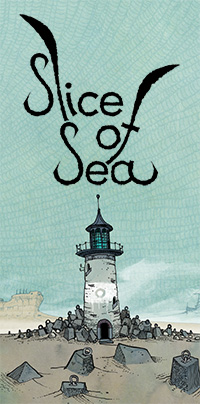Slice of Sea rewiev on PC Gamer
October 23, 2022
 Slice of Sea wants you to point and click every inch of its hand-illustrated landscapes.
Slice of Sea wants you to point and click every inch of its hand-illustrated landscapes.
Slice of Sea’s beautiful and soothing façade hides a prickly adventure from the Flash era.
I grew up playing point-and-click adventures, cutting my teeth on Sierra’s crushingly cruel quests before settling down with Lucasarts’ more freewheeling romps, but I would never consider myself an expert at the genre. New adventure game Slice of Sea reminded me why: There are evolutionary branches of the adventure game that my brain is just not made for, and this game is a direct descendant of a particularly demanding and thorny lineage.
Slice of Sea is the latest hand-painted puzzle adventure from prolific comic author and indie developer Mateusz Skutnik, who’s been releasing games since the Flash era. Most notable are the thirteen adventures in his Submachine series and the eight Daymare Town games. These escape room-esque adventures were defined by their detached and lonely vibes. Aside from the occasional scrawled note and item name to nudge players in the right direction, progress came purely through poking and prodding at strange devices across multiple screens, intuiting their connections and purpose. There were no cruel and sudden deaths to suffer, but progress required your intuition to line up with the developer’s intent.
Slice of Sea initially appears to be different. Players control Seaweed, a little oceanic gremlin piloting a pair of Wallace & Gromit-esque techno-trousers. Using the arrow keys (or WASD) you can steer them through a gorgeous watercolour world on a wordlessly-told pilgrimage to return to the ocean. Seaweed can’t do much by themselves, so it’s up to you to click on the world to interact with its many objects and machines.
The biggest twist in Slice of Sea’s point-and-click adventuring is that despite having a character on-screen and an inventory of items, there’s no physical restrictions on what you can interact with. Seaweed standing on one rock pillar and an item you need sitting on another, nowhere within reach? Doesn’t matter. Click and the item just blinks into your inventory, ready to use anywhere.
Much like in the Submachine games, you are a disembodied presence, interacting with the world one click at a time. Aside from having to stand on the occasional pressure sensor, Seaweed is just along for the ride as you clear their path.
What a lovely path it is, too. A softly shaded and beautifully illustrated set of scenes, the world of Slice of Sea is fragmented and crumbling, dusty and desolate but not abandoned. There are pockets of civilization and strange people of many species seemingly disinterested in an ambulatory frond of sea flora bounding past, as if this is just a daily occurrence. A seemingly sealed train car half-buried under a sand dune might contain a passenger engrossed in a book, nonplussed at your arrival. There’s this constant sense that this world—its very laws of physics fraying at the edges—is just doing its own thing as you pass through to somewhere else.
If the intent is for the player to linger on each screen and fully absorb what they see, then it’s reinforced—or forced, really—by constant, repetitive pixel-hunting. Interactable buttons and objects are often just a dusting of pixels wide, even on my massive curved monitor. Optional collectibles (for achievements, mostly) are even more hidden, often appearing camouflaged on distant foreground or background items. I frequently found myself sweeping my cursor back and forth, looking for it to change shape for a moment, indicating that I’d brushed something usable.
Even with steady progress and the occasional peek at a video walkthrough, Slice of Sea took me a whole day to finish, and if I’d not had someone else’s notes to crib from it would have taken far longer. My brain was screaming for a hint; a line of dialogue to tell me what is or isn’t working or just a button to highlight interactable objects and room exits. And yet if Slice of Sea handed me any of those things it would lose its identity as a descendant of the Submachine and Daymare Town games. It would no longer be part of the legacy of Flash adventure gaming. It would no longer be Slice of Sea.
While Seaweed’s journey was more of an uphill struggle than I’d expected, I still enjoyed my time with Slice of Sea, even if I did have to turn to others for assistance. Its world is sumptuous and every new screen is a lushly illustrated treat—an intrinsic reward for progress. Every complaint I could level at it could be considered a positive by fans of Skutnik’s earlier works.
I wish I’d enjoyed it as much as I think they will. This is a treat for people who spent hours patiently puzzling their way through the Submachine series, with detail-oriented minds and eagle-sharp eyes.
As frustrating as my experience with it sometimes was, Slice of Sea really is a treat for the eyes and ears. Seaweed’s adventure took me on a tour of a strange and fascinating twilight world, crumbling to dust but still full of life. It was also a reminder that the point-and-click adventure genre is a bigger, more varied place now than ever, filled with interesting mutations in game design. If you’ve the patience for it, don’t mind a little pixel-hunting and (ideally) cut your teeth on the unforgiving Flash era of escape rooms, Slice of Sea is easy to recommend, and it’s out now on Itch.io and Steam for $24.99/£19.49.
But if like me you found solace in Lucasarts’ easygoing puzzle design, perhaps pass on this trip to the beach. Some sandcastles are best observed from a distance.
[source]









